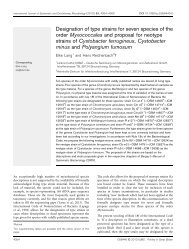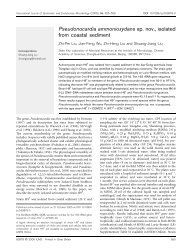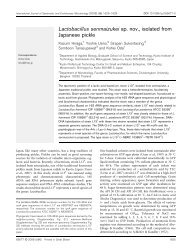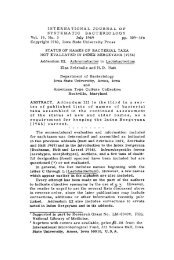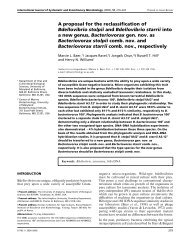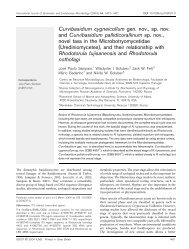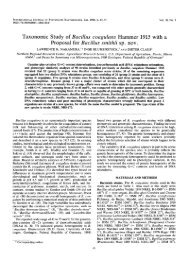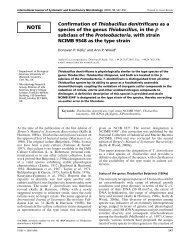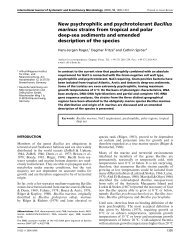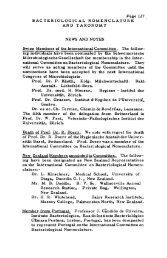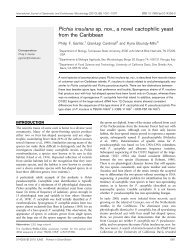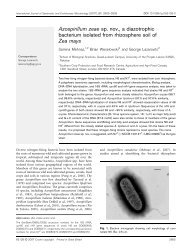Xenophilus aerolatus sp. nov., isolated from air - International ...
Xenophilus aerolatus sp. nov., isolated from air - International ...
Xenophilus aerolatus sp. nov., isolated from air - International ...
Create successful ePaper yourself
Turn your PDF publications into a flip-book with our unique Google optimized e-Paper software.
<strong>International</strong> Journal of Systematic and Evolutionary Microbiology (2010), 60, 327–330 DOI 10.1099/ijs.0.013185-0<br />
Corre<strong>sp</strong>ondence<br />
Soon-Wo Kwon<br />
swkwon@rda.go.kr<br />
The genus <strong>Xenophilus</strong> was proposed as a member of the<br />
family Comamonadaceae by Blümel et al. (2001), with<br />
<strong>Xenophilus</strong> azovorans as the type <strong>sp</strong>ecies. Members of this<br />
genus are characterized as rod-shaped, motile, oxidasepositive<br />
bacteria containing a high DNA G+C content<br />
(70 mol%), C16 : 0, summed feature 7 (containing C18 : 1v7c<br />
and/or C 18 : 1v9t and/or C 18 : 1v12c), C 17 : 0 cyclo and<br />
summed feature 3 (containing C16 : 1v7c and/or iso-C15 : 0<br />
2-OH) as the major fatty acids, and ubiquinone 8 as the<br />
major quinone. This genus was shown to be closely related<br />
to the genera Xylophilus and Hydrogenophaga. However,<br />
the genus <strong>Xenophilus</strong> could be clearly differentiated <strong>from</strong><br />
Abbreviations: ML, maximum-likelihood; MP, maximum-parsimony; NJ,<br />
neighbour-joining.<br />
The GenBank/EMBL/DDBJ accession number for the 16S rRNA gene<br />
sequence of strain 5516S-2 T is EF660342.<br />
Polar lipid profiles and cellular fatty acid compositions of strain 5516S-2 T<br />
and related strains, and a maximum-parsimony tree based on almostcomplete<br />
16S rRNA gene sequences showing the phylogenetic position<br />
of strain 5516S-2 T , are available as supplementary material with the<br />
online version of this paper.<br />
<strong>Xenophilus</strong> <strong>aerolatus</strong> <strong>sp</strong>. <strong>nov</strong>., <strong>isolated</strong> <strong>from</strong> <strong>air</strong><br />
Soo-Jin Kim, 1 Yi-Seul Kim, 1 Hang-Yeon Weon, 1 Rangasamy Anandham, 2<br />
Hyung-Jun Noh 3 and Soon-Wo Kwon 1<br />
1 Korean Agricultural Culture Collection (KACC), National Agrobiodiversity Center, Rural<br />
Development Administration, Suwon 441-707, Republic of Korea<br />
2<br />
Department of Agricultural Microbiology, Agricultural College and Research Institute, Madurai,<br />
India<br />
3 Mushroom Research Division, National Institute of Horticultural & Medicinal Crop, Rural<br />
Development Administration, Suwon 441-707, Republic of Korea<br />
A <strong>nov</strong>el aerobic, Gram-negative, motile, rod-shaped bacterial strain designated 5516S-2 T was<br />
<strong>isolated</strong> <strong>from</strong> an <strong>air</strong> sample taken in Suwon, Republic of Korea. Colonies were yellow-pigmented<br />
and circular with entire margins. 16S rRNA gene sequence analysis showed that strain 5516S-2 T<br />
was closely related to Xylophilus ampelinus DSM 7250 T (97.6 % sequence similarity), Variovorax<br />
soli KACC 11579 T (97.5 %) and <strong>Xenophilus</strong> azovorans DSM 13620 T (97.1 %). However, the<br />
phylogenetic tree indicated that strain 5516S-2 T formed a separate clade <strong>from</strong> <strong>Xenophilus</strong><br />
azovorans. Strain 5516S-2 T di<strong>sp</strong>layed 42, 31 and 30 % DNA–DNA relatedness to the type<br />
strains of <strong>Xenophilus</strong> azovorans, Xylophilus ampelinus and V. soli, re<strong>sp</strong>ectively. The major fatty<br />
acids (.10 % of total fatty acids) were C16 : 0 (33.3 %), C17 : 0 cyclo (18.8 %), C18 : 1v7c (17.5 %)<br />
and summed feature 3 (comprising C16 : 1v7c and/or iso-C15 : 0 2-OH; 13.0 %). The DNA G+C<br />
content was 69 mol%. The major quinone was ubiquinone Q-8. The predominant polar lipids<br />
were dipho<strong>sp</strong>hatidylglycerol, pho<strong>sp</strong>hatidylethanolamine, pho<strong>sp</strong>hatidylglycerol and two unknown<br />
aminopho<strong>sp</strong>holipids. Genotypic and phenotypic characteristics clearly distinguished strain<br />
5516S-2 T <strong>from</strong> closely related <strong>sp</strong>ecies and indicated that it represents a <strong>nov</strong>el <strong>sp</strong>ecies within the<br />
genus <strong>Xenophilus</strong>, for which the name <strong>Xenophilus</strong> <strong>aerolatus</strong> <strong>sp</strong>. <strong>nov</strong>. is proposed. The type strain<br />
is 5516S-2 T (5KACC 12602 T 5DSM 19424 T ).<br />
these two genera based on phylogenetic dendrograms, a<br />
unique fatty acid pattern and several physiological features.<br />
During a course of study on the cultivable bacterial<br />
diversity of <strong>air</strong> samples, one yellow-coloured bacterium,<br />
designated strain 5516S-2 T , was <strong>isolated</strong> and subjected to a<br />
taxonomic investigation. Air samples were collected with<br />
an MAS-100 <strong>air</strong> sampler (Merck; single-stage multiple-hole<br />
impactor) in the downtown outdoor region of Suwon City,<br />
Republic of Korea, on May 16, 2005. The sampler<br />
contained Petri dishes with R2A agar (BBL) containing<br />
cycloheximide (200 mg ml 21 ; Sigma). After sampling,<br />
plates were incubated at 30 uC for 5 days. Variovorax soli<br />
KACC 11579 T , obtained <strong>from</strong> the Korean Agricultural<br />
Culture Collection, Suwon, Korea, and <strong>Xenophilus</strong> azovorans<br />
DSM 13620 T and Xylophilus ampelinus DSM 7250 T ,<br />
both obtained <strong>from</strong> the Deutsche Sammlung von<br />
Mikroorganismen und Zellkulturen, Braunschweig,<br />
Germany, were used as reference strains.<br />
Phenotypic, biochemical and physiological characterizations<br />
were carried out in R2A medium at 30 uC as<br />
described previously (Smibert & Krieg, 1994; Weon et al.,<br />
2007). For transmission electron microscopy, cells were<br />
013185 G 2010 IUMS Printed in Great Britain 327
S.-J. Kim and others<br />
grown for 24 h, negatively stained with 0.5 % (w/v) uranyl<br />
acetate and examined with a LEO model 912AB electron<br />
microscope. Biochemical characteristics were determined<br />
using the API 20NE, API ID 32 GN and API ZYM<br />
(bioMérieux) systems according to the manufacturer’s<br />
instructions. The API ZYM test strip was read after 4 h<br />
incubation at 37 uC and other API test strips were<br />
examined after 10 days at 37 uC.<br />
Cells of strain 5516S-2 T were aerobic, Gram-negative,<br />
motile, non-<strong>sp</strong>ore-forming, short rods, 0.6–0.8 mm in<br />
width and 1.0–1.4 mm in length. Colonies grown on R2A<br />
agar for 3 days were yellow-coloured and circular with<br />
entire margins. Strain 5516S-2 T grew well on R2A,<br />
trypticase soy agar (Difco) and nutrient agar (Difco); weak<br />
growth was observed on MacConkey agar (Difco).<br />
Phenotypic characteristics of strain 5516S-2 T and closely<br />
related <strong>sp</strong>ecies are shown in Table 1.<br />
Whole-cell fatty acids were extracted <strong>from</strong> cell mass<br />
collected after incubation on R2A medium for 2 or 3 days<br />
and analysed according to the standard protocol of the<br />
Table 1. Differential phenotypic traits of strain 5516S-2 T and strains of closely related <strong>sp</strong>ecies<br />
MIDI/Hewlett Packard Microbial Identification system<br />
(Sasser, 1990). Polar lipid profiles were determined<br />
according to Minnikin et al. (1984). Isoprenoid quinones<br />
were extracted and analysed as described by Groth et al.<br />
(1996). The DNA G+C content was analysed by using<br />
HPLC (Mesbah et al., 1989).<br />
The major cellular fatty acid constituents of strain 5516S-2 T<br />
were C 16 : 0 (33.3 %), C 17 : 0 cyclo (18.8 %), C 18 : 1v7c<br />
(17.5 %) and summed feature 3 (containing C16 : 1v7c<br />
and/or iso-C 15 : 0 2-OH; 13.0 %) (Supplementary Table S1,<br />
available in IJSEM Online). The overall cellular fatty acid<br />
profile of strain 5516S-2 T was generally in agreement with<br />
that of <strong>Xenophilus</strong> azovorans DSM 13620 T .Strain5516S-<br />
2 T and <strong>Xenophilus</strong> azovorans could be clearly differentiated<br />
<strong>from</strong> Xylophilus ampelinus based on the presence of C 10 : 0,<br />
C10 : 0 3-OH, C17 : 0 cyclo, C18 : 0 and C18 : 1 2-OH. Strain<br />
5516S-2 T , <strong>Xenophilus</strong> azovorans and Xylophilus ampelinus<br />
could be differentiated <strong>from</strong> some Variovorax <strong>sp</strong>ecies<br />
based on the absence of C12 : 0 and C17 : 0, andthepresence<br />
of C18 : 0 and C18 : 1 2-OH. The predominant polar lipids of<br />
Strains: 1, 5516S-2 T (<strong>Xenophilus</strong> <strong>aerolatus</strong> <strong>sp</strong>. <strong>nov</strong>.); 2, <strong>Xenophilus</strong> azovorans DSM 13620 T ;3,Xylophilus ampelinus DSM 7250 T ;4,Variovorax soli<br />
KACC 11579 T ;5,Variovorax paradoxus DSM 30034 T . Except where indicated, all data were determined in this study. +, Positive; (+), weakly<br />
positive; 2, negative; NA, not available.<br />
Characteristic 1 2 3 4 5<br />
Isolation source Air sample Soil* PlantD Soild Soil§<br />
Morphology Rods Rods* RodsD Rodsd Rods§<br />
Flagella One, polar NA One, polarD One, polard Peritrichous§<br />
Catalase/oxidase +/+ +/+* +/2D +/+d NA/+§<br />
Nitrate reduction 2 2 2 +d +d<br />
Urease + 2 + 2d 2d<br />
Utilization of:<br />
Sodium acetate 2 + 2 2 +<br />
Ascorbic acid 2 + 2 2 +<br />
Casein 2 2 2 2 +<br />
Sodium citrate 2 2 2 2 +<br />
Dextrin + + 2 2 +<br />
Formic acid (+) + (+) + +<br />
D-Glucose 2 + 2 2 +<br />
Glycine 2 2 2 2 +<br />
a-D-Lactose 2 + 2 2 +<br />
L-Malic acid 2 + + + +<br />
Mannitol 2 + + 2 +<br />
Methanol 2 2 2 + 2<br />
Starch + 2 2 2 2<br />
Succinic acid 2 + 2 2 +<br />
Sucrose + + + (+) +<br />
Tartaric acid 2 2 2 2 +<br />
DNA G+C content (mol%) 69 70.4* 68D 67.1d 67.0§<br />
*Data <strong>from</strong> Blümel et al. (2001).<br />
DData <strong>from</strong> Willems et al. (1987).<br />
dData <strong>from</strong> Kim et al. (2006).<br />
§Data <strong>from</strong> Willems et al. (1991).<br />
328 <strong>International</strong> Journal of Systematic and Evolutionary Microbiology 60
strain 5516S-2 T were dipho<strong>sp</strong>hatidylglycerol, pho<strong>sp</strong>hatidylethanolamine,<br />
pho<strong>sp</strong>hatidylglycerol and two unknown<br />
aminopho<strong>sp</strong>holipids (Supplementary Fig. S1, available in<br />
IJSEM Online); the polar lipid profiles of strain 5516S-2 T<br />
and <strong>Xenophilus</strong> azovorans DSM 13620 T were similar. The<br />
major isoprenoid quinone was ubiquinone 8, which is<br />
commonly found in members of the family<br />
Comamonadaceae. The DNA G+C content of strain<br />
5516S-2 T was 69 mol%, which is close to that reported for<br />
<strong>Xenophilus</strong> azovorans DSM 13620 T (70 mol%).<br />
The 16S rRNA gene was amplified by PCR using two<br />
universal primers as described previously (Kwon et al.,<br />
2003). The sequence of the amplified 16S rRNA gene was<br />
analysed using an Applied Biosystems DNA sequencer (ABI<br />
3100). Identification of phylogenetic neighbours and<br />
calculation of p<strong>air</strong>wise 16S rRNA gene sequence similarities<br />
were achieved using the EzTaxon server (Chun et al.,<br />
2007). The 16S rRNA gene sequences were aligned using<br />
CLUSTAL W software (Thompson et al., 1994). Phylogenetic<br />
trees for the datasets were inferred <strong>from</strong> the neighbourjoining<br />
(NJ; Saitou & Nei, 1987), maximum-likelihood<br />
(ML; Felsenstein, 1981) and maximum-parsimony (MP;<br />
Fitch, 1971) methods using MEGA version 3.0 (Kumar et al.,<br />
2004). The stability of relationships was assessed by<br />
performing bootstrap analyses based on 1000 resamplings.<br />
DNA–DNA hybridization was carried out as described by<br />
Seldin & Dubnau (1985). Probe labelling was conducted by<br />
using the non-radioactive DIG-High Prime system (Roche)<br />
and hybridized DNA was visualized using the DIG<br />
luminescent detection kit (Roche). DNA–DNA relatedness<br />
was quantified by using a densitometer (Bio-Rad).<br />
For 16S rRNA gene sequence analysis, continuous stretches<br />
of 1407 bp were obtained and analysed. Strain 5516S-2 T<br />
exhibited 97.6, 97.5 and 97.1 % 16S rRNA gene sequence<br />
similarities to Xylophilus ampelinus DSM 7250 T , V. soli<br />
<strong>Xenophilus</strong> <strong>aerolatus</strong> <strong>sp</strong>. <strong>nov</strong>.<br />
KACC 11579 T and <strong>Xenophilus</strong> azovorans DSM 13620 T ,<br />
re<strong>sp</strong>ectively. The NJ tree indicated that strain 5516S-2 T<br />
formed a monophyletic clade with <strong>Xenophilus</strong> azovorans<br />
DSM 13620 T , which was supported by a moderate<br />
bootstrap value (66 %) (Fig. 1). A similar phenomenon<br />
was also observed in the ML tree (data not shown). The<br />
MP tree showed loose clustering between strain 5516S-2 T<br />
and <strong>Xenophilus</strong> azovorans DSM 13620 T (Supplementary<br />
Fig. S2, available in IJSEM Online). Strain 5516S-2 T<br />
di<strong>sp</strong>layed 42, 31 and 30 % DNA–DNA relatedness to the<br />
type strains of <strong>Xenophilus</strong> azovorans, Xylophilus ampelinus<br />
and V. soli, re<strong>sp</strong>ectively.<br />
Although strain 5516S-2 T showed highest sequence similarity<br />
to the type strains of Xylophilus ampelinus and V.<br />
soli, the phylogenetic dendrograms indicated that strain<br />
5516S-2 T was closely related to <strong>Xenophilus</strong> azovorans. The<br />
fatty acid composition and polar lipid pattern clearly<br />
revealed that strain 5516S-2 T was a member of the genus<br />
<strong>Xenophilus</strong>. However, strain 5516S-2 T could be differentiated<br />
<strong>from</strong> <strong>Xenophilus</strong> azovorans on the basis of the<br />
presence of urease, differences in the assimilation patterns<br />
of several substrates embedded in API test strips, and<br />
qualitative and quantitative differences in fatty acid<br />
composition. Based on the data obtained in this study, it<br />
is concluded that strain 5516S-2 T represents a <strong>nov</strong>el<br />
<strong>Xenophilus</strong> <strong>sp</strong>ecies, for which the name <strong>Xenophilus</strong><br />
<strong>aerolatus</strong> <strong>sp</strong>. <strong>nov</strong>. is proposed.<br />
Description of <strong>Xenophilus</strong> <strong>aerolatus</strong> <strong>sp</strong>. <strong>nov</strong>.<br />
<strong>Xenophilus</strong> <strong>aerolatus</strong> (ae.ro.la9tus. Gr. n. aer <strong>air</strong>; L. part. adj.<br />
latus -a -um carried; N.L. masc. part. adj. <strong>aerolatus</strong><br />
<strong>air</strong>borne).<br />
Cells are Gram-negative, non-<strong>sp</strong>ore-forming, aerobic rods,<br />
0.6–0.8 mm in width and 1.0–1.4 mm in length. Motile with<br />
Fig. 1. Neighbour-joining tree based on almost-complete 16S rRNA gene sequences showing the phylogenetic position of<br />
strain 5516S-2 T . Numbers at nodes indicate percentages of 1000 bootstrap resamplings; only values .40 % are given. Bar,<br />
0.005 substitutions per nucleotide position.<br />
http://ijs.sgmjournals.org 329
S.-J. Kim and others<br />
a single polar flagellum. Catalase- and oxidase-positive.<br />
Colonies are yellow and circular with entire margins.<br />
Grows at 10–35 uC (optimum, 25–30 uC), at pH 5.0–9.0<br />
(optimum, pH 6.0–8.0) and with 0–2 % NaCl (optimum,<br />
0–1 %). Hydrolyses hypoxanthine, tyrosine, Tween 80 and<br />
xanthine, but not casein, chitin, carboxymethylcellulose,<br />
DNA, pectin or starch. In addition to the characteristics<br />
shown in Table 1, assimilates itaconic acid, suberic acid,<br />
sodium acetate, lactic acid, L-alanine, potassium 5-ketogluconate,<br />
3-hydroxybenzoic acid, D-sorbitol, propionic acid,<br />
valeric acid, L-histidine, potassium 2-ketogluconate, 3hydroxybutyric<br />
acid, 4-hydroxybenzoic acid and L-proline,<br />
but does not assimilate L-rhamnose, D-ribose, inositol,<br />
sucrose, sodium malonate, glycogen, L-serine, salicin,<br />
melibiose or L-fucose. Positive for alkaline pho<strong>sp</strong>hatase,<br />
esterase (C4), esterase lipase (C8) and leucine arylamidase;<br />
negative for lipase (C14), valine arylamidase, cystine<br />
arylamidase, trypsin, a-chymotrypsin, acid pho<strong>sp</strong>hatase,<br />
naphthol-AS-BI-pho<strong>sp</strong>hohydrolase, a-galactosidase, bgalactosidase,<br />
b-glucuronidase, a-glucosidase, b-glucosidase,<br />
N-acetyl-b-glucosaminidase, a-mannosidase and a-fucosidase.<br />
The major isoprenoid quinone is ubiquinone Q-8. The<br />
major cellular fatty acids are C16 : 0, C17 : 0 cyclo, C18 : 1v7c<br />
and summed feature 3 (containing C16 : 1v7c and/or iso-<br />
C15 : 0 2-OH). Dipho<strong>sp</strong>hatidylglycerol, pho<strong>sp</strong>hatidylethanolamine,<br />
pho<strong>sp</strong>hatidylglycerol and two unknown aminopho<strong>sp</strong>holipids<br />
are the predominant polar lipids. The DNA G+C<br />
content of strain 5516S-2 T is 69 mol%.<br />
The type strain is 5516S-2 T (5KACC 12602 T 5DSM<br />
19424 T ), <strong>isolated</strong> <strong>from</strong> <strong>air</strong> samples, Suwon, Republic of<br />
Korea.<br />
Acknowledgements<br />
This work was supported by a grant (no. 20080401034028) <strong>from</strong> the<br />
BioGreen 21 Program, Rural Development Administration, Republic<br />
of Korea.<br />
References<br />
Blümel, S., Busse, H.-J., Stolz, A. & Kämpfer, P. (2001). <strong>Xenophilus</strong><br />
azovorans gen. <strong>nov</strong>., <strong>sp</strong>. <strong>nov</strong>., a soil bacterium that is able to degrade<br />
azo dyes of the Orange II type. Int J Syst Evol Microbiol 51, 1831–1837.<br />
Chun, J., Lee, J.-H., Jung, Y., Kim, M., Kim, S., Kim, B. K. & Lim, Y. W.<br />
(2007). EzTaxon: a web-based tool for the identification of<br />
prokaryotes based on 16S ribosomal RNA gene sequence. Int J Syst<br />
Evol Microbiol 57, 2259–2261.<br />
Felsenstein, J. (1981). Evolutionary trees <strong>from</strong> DNA sequences: a<br />
maximum likelihood approach. J Mol Evol 17, 368–376.<br />
Fitch, W. M. (1971). Toward defining the course of evolution:<br />
minimum change for a <strong>sp</strong>ecific tree topology. Syst Zool 20, 406–416.<br />
Groth, I., Schumann, P., Weiss, N., Martin, K. & Rainey, F. A. (1996).<br />
Agrococcus jenensis gen. <strong>nov</strong>., <strong>sp</strong>. <strong>nov</strong>., a new genus of actinomycetes<br />
with diaminobutyric acid in the cell wall. Int J Syst Bacteriol 46,<br />
234–239.<br />
Kim, B.-Y., Weon, H.-Y., Yoo, S.-H., Lee, S.-Y., Kwon, S.-W., Go, S.-J.<br />
& Stackebrandt, E. (2006). Variovorax soli <strong>sp</strong>. <strong>nov</strong>., <strong>isolated</strong> <strong>from</strong><br />
greenhouse soil. Int J Syst Evol Microbiol 56, 2899–2901.<br />
Kumar, S., Tamura, K. & Nei, M. (2004). MEGA3: integrated software<br />
for molecular evolutionary genetics analysis and sequence alignment.<br />
Brief Bioinform 5, 150–163.<br />
Kwon, S.-W., Kim, J.-S., Park, I.-C., Yoon, S.-H., Park, D.-H., Lim, C.-K.<br />
& Go, S.-J. (2003). Pseudomonas koreensis <strong>sp</strong>. <strong>nov</strong>., Pseudomonas<br />
umsongensis <strong>sp</strong>. <strong>nov</strong>. and Pseudomonas jinjuensis <strong>sp</strong>. <strong>nov</strong>., <strong>nov</strong>el<br />
<strong>sp</strong>ecies <strong>from</strong> farm soils in Korea. Int J Syst Evol Microbiol 53, 21–27.<br />
Mesbah, M., Premachandran, U. & Whitman, W. B. (1989). Precise<br />
measurement of the G+C content of deoxyribonucleic acid by highperformance<br />
liquid chromatography. Int J Syst Bacteriol 39, 159–167.<br />
Minnikin, D. E., O’Donnell, A. G., Goodfellow, M., Alderson, G.,<br />
Athalye, M., Schaal, A. & Parlett, J. H. (1984). An integrated<br />
procedure for the extraction of bacterial isoprenoid quinones and<br />
polar lipids. J Microbiol Methods 2, 233–241.<br />
Saitou, N. & Nei, M. (1987). The neighbor-joining method: a new<br />
method for reconstructing phylogenetic trees. Mol Biol Evol 4,<br />
406–425.<br />
Sasser, M. (1990). Identification of bacteria by gas chromatography of<br />
cellular fatty acids, MIDI Technical Note 101. Newark, DE: MIDI Inc.<br />
Seldin, L. & Dubnau, D. (1985). Deoxyribonucleic acid homology<br />
among Bacillus polymyxa, Bacillus macerans, Bacillus azotofixans, and<br />
other nitrogen-fixing Bacillus strains. Int J Syst Bacteriol 35, 151–154.<br />
Smibert, R. M. & Krieg, N. R. (1994). Phenotypic characterization. In<br />
Methods for General and Molecular Bacteriology, pp. 607–654. Edited<br />
by P. Gerhardt, R. G. E. Murray, W. A. Wood & N. R. Krieg.<br />
Washington, DC: American Society for Microbiology.<br />
Thompson, J. D., Higgins, D. G. & Gibson, T. J. (1994). CLUSTAL W:<br />
improving the sensitivity of progressive multiple sequence alignment<br />
through sequence weighting, position-<strong>sp</strong>ecific gap penalties and<br />
weight matrix choice. Nucleic Acids Res 22, 4673–4680.<br />
Weon, H.-Y., Kim, B.-Y., Hong, S.-B., Joa, J.-H., Nam, S.-S., Lee, K.-H.<br />
& Kwon, S.-W. (2007). Skermanella aerolata <strong>sp</strong>. <strong>nov</strong>., <strong>isolated</strong> <strong>from</strong> <strong>air</strong>,<br />
and emended description of the genus Skermanella. Int J Syst Evol<br />
Microbiol 57, 1539–1542.<br />
Willems, A., Gillis, M., Kersters, K., Van den Broecke, L. & De Ley, J.<br />
(1987). Transfer of Xanthomonas ampelina Panagopoulos 1969 to a<br />
new genus, Xylophilus gen. <strong>nov</strong>., as Xylophilus ampelinus<br />
(Panagopoulos 1969) comb. <strong>nov</strong>. Int J Syst Bacteriol 37, 422–430.<br />
Willems, A., De Ley, J., Gillis, M. & Kersters, K. (1991).<br />
Comamonadaceae, a new family encompassing the acidovorans<br />
rRNA complex, including Variovorax paradoxus gen. <strong>nov</strong>., comb.<br />
<strong>nov</strong>., for Alcaligenes paradoxus (Davis 1969). Int J Syst Bacteriol 41,<br />
445–450.<br />
330 <strong>International</strong> Journal of Systematic and Evolutionary Microbiology 60



